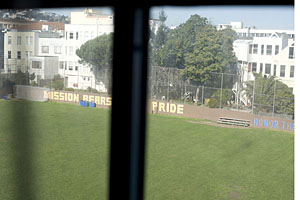
Photo: Mark Murrmann
Editors’ Note: This education dispatch is part of an ongoing series reported from Mission High School, where education writer Kristina Rizga is embedded for the year. Click here to see more of MoJo’s recent education coverage, or follow Kristina’s writing on Twitter or with this RSS Feed.
[Previous Mission High dispatch: Will Darrell flunk this test?]
There’s a spring in my step as I walk to Mission High School this morning. I can’t wait to tell Natalie—the aspiring astronaut who was “kicked out” of two charter schools—that my NASA friend has agreed to meet with her and give her some college advice.
But when I enter Ms. Bowman’s World History class, Natalie’s not there. Where is she? I wonder. Is she okay? At least Pedro’s here, I notice.
Bowman begins class by writing the mnemonic “EMPIRE” on a white dry-erase board for a review of the motivations behind Imperialism. Each letter of EMPIRE stands for a key concept: “E” for economic interests, “M” for military bases, “P” for patriotism and nationalism, “I” for ideology of Social Darwinism, etc.
“I want to answer the ideology question, please!” says Pedro, the sweet skateboarding kid whose T-shirt hides gang-inflicted knife scars. He has already answered the first two questions and seems to have a hard time staying still today. “Just a minute, Pedro,” Bowman responds. “I want to allow others to participate in our discussion.” “A body of beliefs!” Pedro yells anyway.
Pedro starts chatting with his friends in a loud voice. Bowman first offers him the choice of moving over a few seats. He refuses, promising to stop talking, but doesn’t follow through. Bowman then asks Pedro to read out loud the four rules she has written near the classroom door: “Be respectful, no cross-talk, step up, and step back.”
Pedro reads them out loud, then continues to joke around with his friends. Nearby, a girl is reading a Bible with a pink cover, ignoring the other students. Last week she participated in collective discussions. This week, she seems annoyed by Pedro and protests with silence. “Pedro, could you come with me for a second?” Bowman asks in a calm voice. The two walk outside the classroom for a minute. Bowman walks back in without Pedro and keeps teaching. Three minutes later, Pedro reenters the class, sits down, and starts working calmly on an exercise with the rest of the class.
As the students write in silence for a moment, it hits me: This class feels completely different from last week. It’s not just Pedro’s behavior. The students are still learning, but there’s more tension, more cross-talk, less engagement as a group.
After class I talk to Bowman; she agrees. “A part of it is not having Natalie in the class today,” she muses. Since Natalie‘s always very engaged in class discussions, it’s possible that her participation balances out Pedro’s desire to be the center of attention, and other students benefit. But Bowman doesn’t seem too worried. “Class dynamics change constantly,” she says. “It’s a constant work in progress.”
I now have heard many teachers at Mission High school refer to these small, frequent cultural shifts in a classroom as little bumps. Skilled teachers feel them right away and know exactly how to smooth them out.














